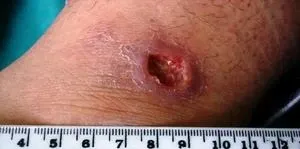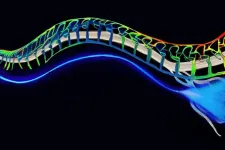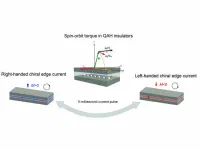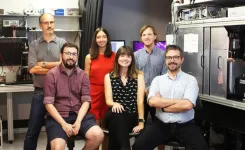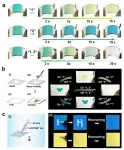(Press-News.org) While the overall incidence and death rates from cervical cancer have dropped in the U.S., the opposite has been occurring in Appalachian Kentucky – a steady increase. The death rate from cervical cancer in Appalachian Kentucky is now twice that of the national rate.
A team of cancer population scientists from MUSC Hollings Cancer Center and the University of Kentucky Markey Cancer Center documented the increase through investigation of county-level data from 2000 through 2019. Their findings are published this month in JAMA Network Open.
“The rapidly growing disparities that we're observing in the Appalachia region are disturbing, particularly in the era of screening availability and advancements,” said Ashish Deshmukh, Ph.D., senior author on the paper. He is co-leader of the Cancer Control Research Program at Hollings.
Krystle Lang Kuhs, Ph.D., co-leader of the Cancer Prevention and Control Research Program at Markey and a co-author on the paper, said the findings underscore the importance of ensuring that every woman has access to preventive services.
“With advances in HPV vaccination and screening, cervical cancer is now a completely preventable disease,” Kuhs said.
The researchers analyzed data from the National Cancer Institute's Surveillance Epidemiology and End Results for Kentucky and found that cervical cancer incidence in the Appalachian region increased nearly 3% per year over the last decade. The death rate also trended upward in the Appalachian region, at 4.5% per year. Meanwhile, the rates in non-Appalachian counties in Kentucky, as well as nationally, are declining.
Deshmukh, who studies the epidemiology of and prevention pathways for cancers caused by HPV, previously documented a nationwide increase in cervical cancer in women in their early 30s. That paper, published in JAMA, noted that one possible reason for the increase was because of a decline in screenings among women in their 20s.
This publication was a result of collaboration between Deshmukh and Kuhs after they compared notes and reflected on the challenges that both South Carolina and Kentucky face in getting prevention and screening services to rural areas.
“We started exploring patterns in cancer incidence and mortality, as a result of our mutual curiosity, and we found this disturbing rise,” Deshmukh said.
The increase is most startling for distant-stage cancer, or cancer that isn’t diagnosed until it has already spread through the body. For distant-stage cervical cancer, the researchers found an increase of 5.5% per year.
Robust data available through the Kentucky Cancer Registry allowed the researchers to study county-level trends, Deshmukh said. He thinks that the example of Kentucky could point to hidden issues in other regions with high levels of persistent poverty and problems with access to screening and follow-up care.
Deshmukh added that, given the descriptive nature of the study, which lacks information on screening use and risk factors, they couldn’t draw conclusions about the reasons for the increase. However, he said, given the rising rates of distant-stage cancer and deaths, it is clear that the data shows a true increase as a result of lack of screening and follow-up care in Appalachian Kentucky. This isn’t a case of a disease appearing to be more prevalent only because screening is catching more cases.
“The increasing incidence and mortality due to cervical cancer in Appalachia suggests that we are not doing enough to ensure that women residing in rural areas have access to the preventive and medical services they need,” Kuhs said.
Bringing cervical cancer screening to rural areas
Screening is critical to preventing cervical cancer. Guidelines recommend that all women ages 21 through 29 have a Pap smear every three years. Women between 30 and 65 should co-test, which means getting a Pap smear along with an HPV test, every five years.
In South Carolina, Hollings brings cervical cancer screenings to rural communities through its Mobile Health Unit, which provides mammography, cervical cancer screening and skin checks. The unit visited nine counties and provided cervical cancer screenings to 288 patients in the first nine months of the year.
And through a Duke Endowment grant, the cancer center is working with hospitals in the MUSC Health Regional Health Network to direct vulnerable populations to screenings for five cancers with high mortality rates in South Carolina, including cervical cancer.
Markey also has several ongoing initiatives to improve the uptake of cervical cancer prevention services in Appalachia, including a P01 program grant involving four university partners and 35 Appalachian health clinics. Investigators are working directly with community members to plan and implement methods to increase cervical cancer screening and HPV vaccination as well as reduce tobacco use.
The HPV vaccine, which can protect against the strains of HPV that can cause six types of cancer, is recommended for boys and girls at 11 or 12 years old. People can get the vaccine on a catch-up schedule up to age 26, and those up to age 45 may also be eligible for the vaccine if their doctors think it would be beneficial in their individual situations.
Marvella Ford, Ph.D., associate director of Population Science and Community Outreach and Engagement (COE) at Hollings, said that her office works closely with Deshmukh and other investigators to identify areas with low HPV vaccination rates.
"We are transforming the delivery of the HPV vaccine in South Carolina by improving its accessibility through our mobile health approach,” she said. “Working in collaboration with Dr. Deshmukh and his team, we are disseminating evidence-based findings related to the HPV vaccine to the communities we serve while simultaneously gaining the input and direction from the community into the development of a new data visualization tool led by Dr. Deshmukh and his team.
“The bi-directional and community-engaged partnership between the COE Office, Dr. Deshmukh and team and community members has informed Dr. Deshmukh’s innovative research here in South Carolina, paving the way for new public health developments in cancer prevention and control.”
Reaching vulnerable populations
Deshmukh noted that there are other pockets of medically underserved areas in the country, which often coincide with areas of persistent poverty and can experience higher cancer rates. Puerto Rico, for example, is also seeing a rapid increase in cervical cancer rates.
Deshmukh is working with colleagues at the University of Puerto Rico Comprehensive Cancer Center to study the most effective method for increasing screening rates there.
The geographic disparities that are seen in Puerto Rico, Appalachian Kentucky and perhaps elsewhere require public health approaches tailored to the unique barriers of each region, Deshmukh said.
Other authors of the study include Haluk Damgacioglu, Ph.D., Kalyani Sonawane, Ph.D., and Elizabeth Hill, Ph.D., from Hollings and Todd Burus from Markey.
About MUSC Hollings Cancer Center
MUSC Hollings Cancer Center is South Carolina’s only National Cancer Institute-designated cancer center with the largest academic-based cancer research program in the state. The cancer center comprises more than 130 faculty cancer scientists and 20 academic departments. It has an annual research funding portfolio of more than $44 million and sponsors more than 200 clinical trials across the state. Dedicated to preventing and reducing the cancer burden statewide, the Hollings Office of Community Outreach and Engagement works with community organizations to bring cancer education and prevention information to affected populations. Hollings offers state-of-the-art cancer screening, diagnostic capabilities, therapies and surgical techniques within its multidisciplinary clinics. Hollings specialists include surgeons, medical oncologists, radiation oncologists, radiologists, pathologists, psychologists and other clinical providers equipped to provide the full range of cancer care. For more information, visit hollingscancercenter.musc.edu.
END
Researchers document dramatic increase in advanced stage cervical cancer and deaths from cervical cancer in Appalachian Kentucky
2023-10-19
ELSE PRESS RELEASES FROM THIS DATE:
Researchers discover associations among PTSD, diet, and the gut microbiome
2023-10-19
Study suggests that adhering to a Mediterranean diet may alleviate or prevent posttraumatic stress disorder (PTSD) symptoms
The human gut microbiome has a significant impact on our health. Research has shown that it can influence the development and response of emotions, but the relationship between posttraumatic stress disorder (PTSD) and the gut microbiome has been unexplored. PTSD is a fear-based mental health disorder that develops in some individuals who experience a disturbing and horrifying situation involving severe injury, actual or threat of death, or violence. A new study by investigators from Brigham and Women’s Hospital, a founding member of the Mass General Brigham healthcare ...
COVID-19 vaccination willingness and reasons for vaccine refusal
2023-10-19
About The Study: The findings of this study that involved the use of data from Hong Kong and Singapore suggest that trust in health authorities was fundamental to overcoming COVID-19 vaccine hesitancy. As such, engendering trust in health care professionals, experts, and public health agencies should be incorporated into pandemic preparedness and response.
Authors: Michael Y. Ni, M.D., of the University of Hong Kong, is the corresponding author.
To access the embargoed study: Visit our For The Media website at this link https://media.jamanetwork.com/
(doi:10.1001/jamanetworkopen.2023.37909)
Editor’s Note: Please see the article ...
Developmental trajectory of body weight in youths at risk for major mood disorders
2023-10-19
About The Study: In this study of 394 individuals, females with a family history of mood disorders were prone to weight gain starting around puberty and predating mood disorder onset. Early interventions aiming to prevent adverse mental and physical outcomes in this vulnerable group need to start in childhood.
Authors: Rudolf Uher, M.D., Ph.D., of Dalhousie University in Halifax, Nova Scotia, Canada, is the corresponding author.
To access the embargoed study: Visit our For The Media website at this link https://media.jamanetwork.com/
(doi:10.1001/jamanetworkopen.2023.38540)
Editor’s ...
Soft optical fibers block pain while moving and stretching with the body
2023-10-19
Scientists have a new tool to precisely illuminate the roots of nerve pain.
Engineers at MIT have developed soft and implantable fibers that can deliver light to major nerves through the body. When these nerves are genetically manipulated to respond to light, the fibers can send pulses of light to the nerves to inhibit pain. The optical fibers are flexible and stretch with the body.
The new fibers are meant as an experimental tool that can be used by scientists to explore the causes and potential treatments for peripheral nerve disorders in animal models. ...
Electrical control of quantum phenomenon could improve future electronic devices
2023-10-19
UNIVERSITY PARK, Pa. — A new electrical method to conveniently change the direction of electron flow in some quantum materials could have implications for the development of next-generation electronic devices and quantum computers. A team of researchers from Penn State developed and demonstrated the method in materials that exhibit the quantum anomalous Hall (QAH) effect — a phenomenon in which the flow of electrons along the edge of a material does not lose energy. The team described the work in a paper appearing today (Oct. 19) in the journal Nature ...
A change in rigidity switches the function of protein condensates involved in sensing touch
2023-10-19
Touch plays a fundamental role in our physical, emotional, and social well-being. From a primary way of conveying emotions to sensory integration, it is crucial for the complex growth of cognitive, emotional, social, and behavioral abilities especially during the early development of infants and children. Touch allows us to build connections with others, eases pain and stress, and helps us to understand the world around us giving crucial information such as the texture, temperature, and shape of objects.
When sensing any stimuli, such as when the body is being touched, the mechanical signals are transformed into biological responses ...
From square to cube: Hardware processing for AI goes 3D, boosting processing power
2023-10-19
A breakthrough development in photonic-electronic hardware could significantly boost processing power for AI and machine learning applications.
The approach uses multiple radio frequencies to encode data, enabling multiple calculations to be carried out in parallel.
The method shows promise for outperforming state-of-the-art electronic processors, with further enhancements possible.
In a paper published today in Nature Photonics, researchers from the University of Oxford, along with collaborators from the Universities of Muenster, Heidelberg, and Exeter, report on their development ...
Self-powered flexible multicolor electrochromic devices for information displays
2023-10-19
In recent years, self-powered electrochromic (EC) devices have shown significant potential in various fields such as optoelectronics, sensors, and security systems. These self-powered EC systems, capable of reversible color switching without external power sources, have garnered considerable interest for next-generation electronic devices. However, this field is still in its infancy, with several unresolved challenges, including monochromatic displays, limited cycle durability, and the use of aqueous electrolytes. All these limitations have become ...
Urgent action needed to address climate change threats to coastal areas
2023-10-19
Global coastal adaptations are ‘incremental in scale’, short-sighted and inadequate to address the root causes of vulnerability to climate change, according to an international team of researchers.
The 17 experts, including Prof Robert Nicholls, Professor of Climate Adaptation at the University of East Anglia (UEA), have contributed to the paper, ‘Status of global coastal adaptation’, which is published today in Nature Climate Change.
Prof Nicholls said: “Recent analyses conclude that despite adaptation undertaken in all regions and sectors, global action remains incremental in scale: policies and projects ...
Cancer drug that targets two immune-evading tumor tactics performs well in early clinical trial
2023-10-19
A “two-for-one” cancer immunotherapy is potentially more effective and at least as safe as standard immunotherapies, physician-scientists from UPMC Hillman Cancer Center who led an international, early-phase clinical trial report today in the journal Nature Medicine.
The findings, which involved hundreds of patients with different types of advanced solid tumors or blood cancers, point to an enticing new path for bispecific therapies that more efficiently unleash the patient’s own immune system to eliminate the cancer.
“No approved ...

